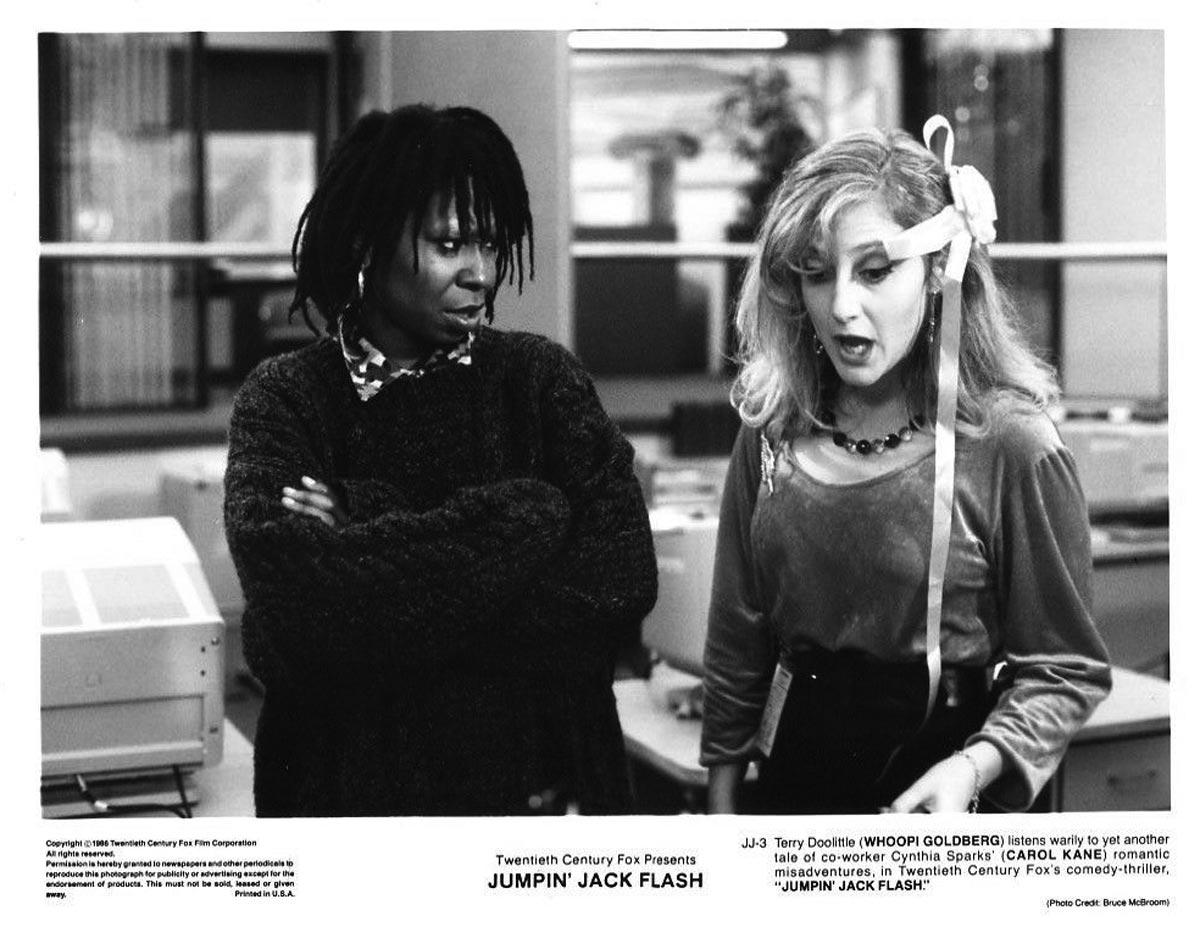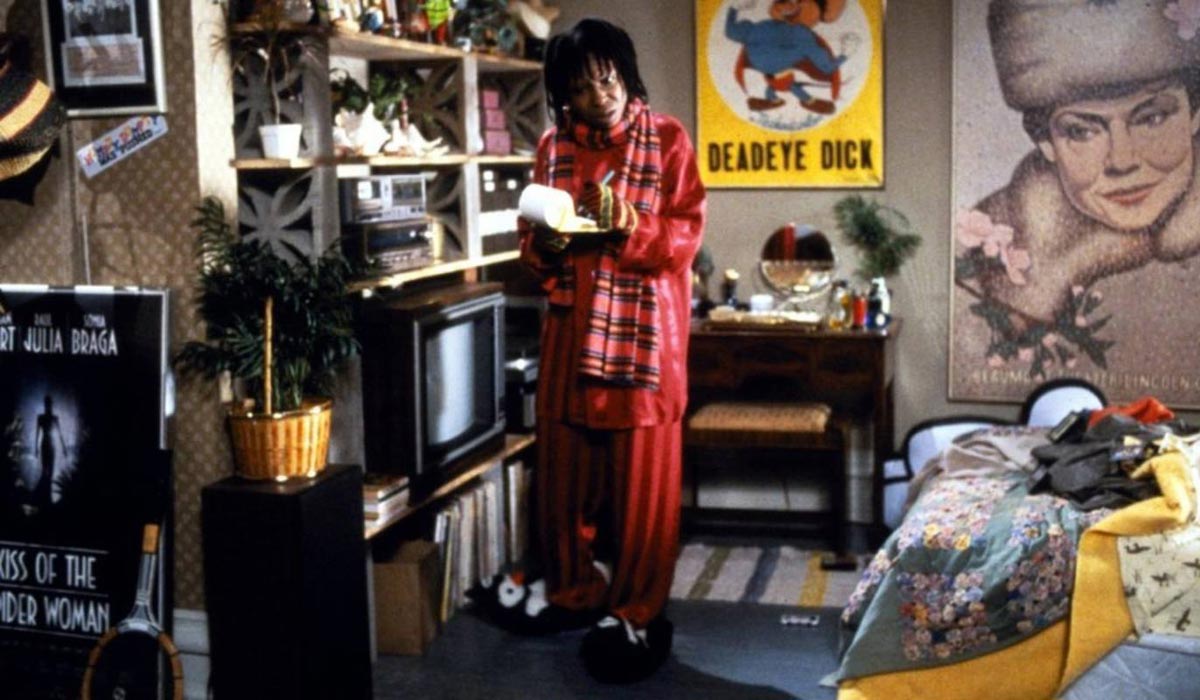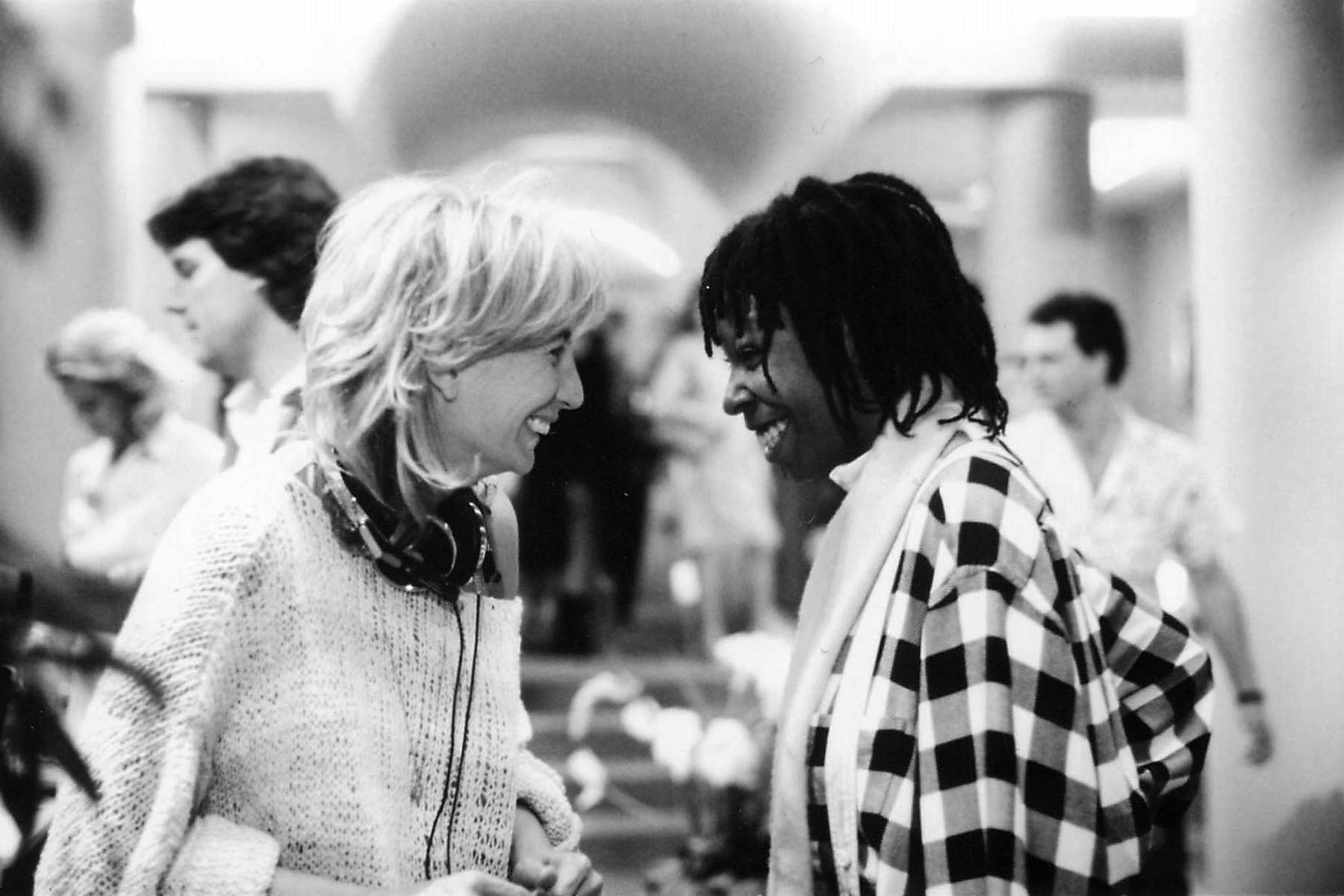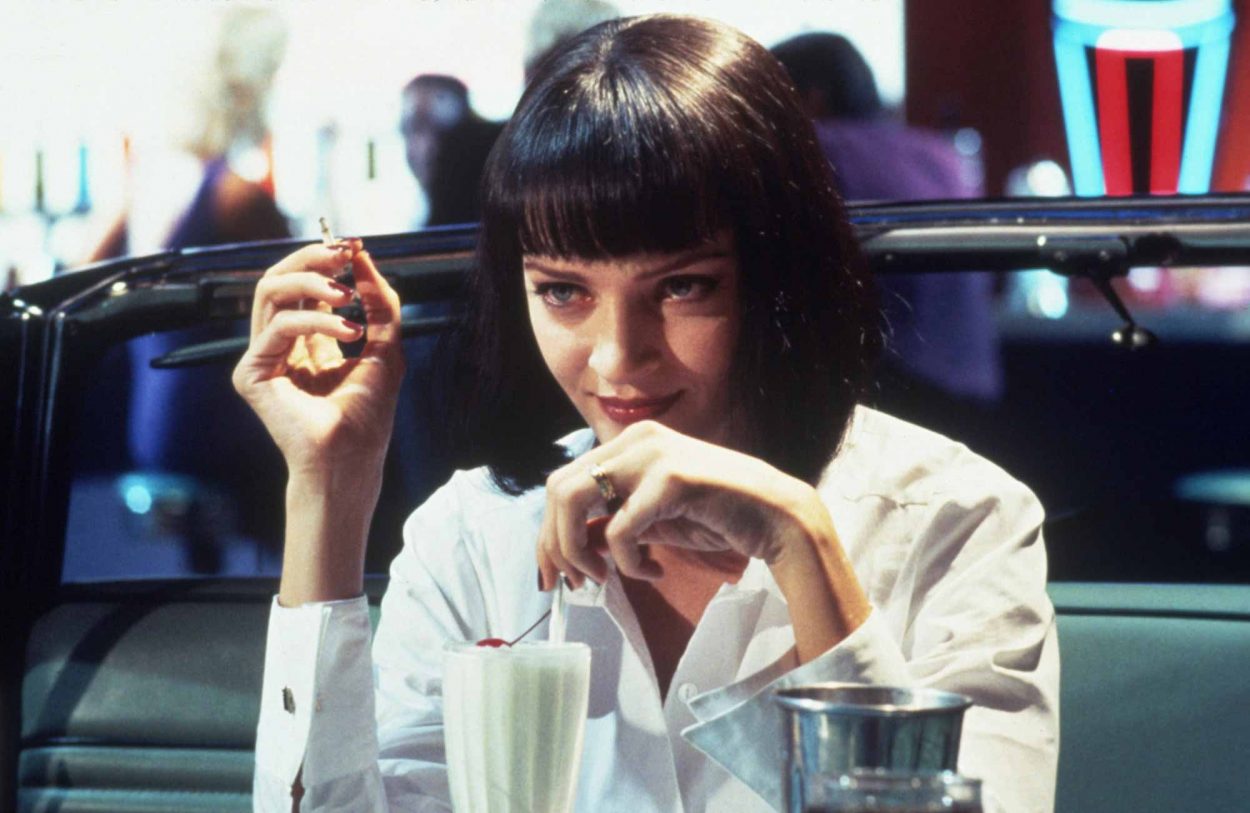Would it surprise you to learn that the writer of Die Hard (John McTiernan, 1988), 48 Hours (Walter Hill, 1982) and Commando (Mark L. Lester, 1985) was one of the uncredited authors of Jumpin’ Jack Flash (Penny Marshall, 1986)? Steven E. de Souza was one of several people who contributed his skills to a film that many did not think would see the light of day based on its rocky beginnings. Writers Nancy Myers and Charles Shyer went by pseudonyms (Patricia Irving and J.W. Melville, respectively) while respected novelist and screenplay writer Richard Price’s credit can be found only in 1980s writers’ columns and collector sites. Howard Zieff was originally slated to direct the film and it was planned as a Shelley Long vehicle. Clearly, neither of those things occurred. While Zieff had directed work like Private Benjamin (1980) and My Girl (1991) he was most famous for his commercial work, including the groundbreaking “You Don’t Have To Be Jewish” Levy’s rye bread campaign and the “Spicy Meatball” ad for Alka-Seltzer.
But the Jumpin’ Jack Flash campaign was handed to someone else. Whoopi Goldberg was asked about the directorial change by the Reno Gazette in 1986.“I don’t know what happened,” she said, “I had nothing to do with it, though they made it seem that I did. The producer just called me one day and said, ‘We’re changing directors.’ I don’t know what happened. I just know it was awful.” While several articles mention a rift between Goldberg and Zieff or “creative differences on set,” Zieff’s departure was a career-changer for one woman: Penny Marshall. At the time, Marshall had been considering directing Peggy Sue Got Married (which then went to Francis Ford Coppola). In an interview at the time, Marshall stated that with Flash, “I didn’t have time to think, ‘Should I or shouldn’t I?’…They wanted me. I go where I’m wanted. I said, ‘OK, I’ll just jump right in here.’ I have the Lone Ranger Syndrome. I tend to work best under pressure.”
Jumpin’ Jack Flash was her feature film directorial debut. Having worked previously in television for years (both acting and directing), she was accustomed to the entertainment business. But the leap from the small to big screen was significant. She hadn’t been eager to transition. She had entertained the idea, read scripts, but, she remarked, “When I’d get to the place where it said, ‘and then they put underpants on their heads,’ I would lose interest…I was scared stiff [about directing Jumpin’ Jack Flash] I learned a lot, and I did need to learn. They were nice to let me learn. It was like cramming four years of college into one semester. Although directing this movie was a real hard experience, in retrospect I can always laugh at something.” This was the last film where Marshall would say something like “they were nice to let me learn.” After Flash, this woman assumed her agency and blasted the balls off of Hollywood, making a series of hit films that let them know that she was far more than Laverne DeFazio and worlds away from just “Garry Marshall’s little sister.”

Jumpin’ Jack Flash is not an ordinary ’80s film. A spy film, action comedy, film noir, and love letter to independent NYC women, Jumpin’ Jack Flash raises valuable discussions about blackness and femininity/feminine aesthetics. For a film that has the energy and dynamism of every beloved Lethal Weapon/Beverly Hills Cop/Die Hard from the same time period, this is a lot to include. But it all works!
For die-hard (hehehe) action fans, Jumpin’ Jack Flash will give you everything you wanted in a film: explosions, intrigue, wrong woman scenarios and well-cast villains with über creepy henchmen. Even a quintessential New York dock chase scene with an AWESOME shoot-out! This is a serious popcorn movie. You will be cheering and clapping… Jumpin’ Jack Flash isn’t just a gas it’s a RUSH! While many 80s spy thrillers featured fast-thinking and smooth male protagonists, the action comedies tended towards non-conformist dudes solving crimes either alone or with a straight-man buddy. Flash works on those tropes and yet is a wholly different film. While it contains the same energy of any of its peers, it flips the script, gender-wise.

Jumpin’ Jack Flash’s heroine is Terry Doolittle (Whoopi Goldberg), an expert computer programmer/bank technician in New York. While the world of computer science has become more diverse in the 31 years since the film’s release, it was still rather unusual for a woman to have this career in 1986, let alone master it – especially a woman of color. Terry is unquestionably one of my favorite action characters of the 1980s; she’s smart, vivacious and doesn’t take anyone’s shit. Going to sleep each night clutching a mystery paperback to her chest, her apartment is plastered, wall-to-wall, with posters of classic films centered on criminality and/or non-conformity like Fritz Lang’s Metropolis (1927), Attack of the 50 Foot Woman (Nathan H. Juran, 1958) and The Maltese Falcon (John Huston, 1941).
The workspace (which features the awesome acting talents of none other than Jon Lovitz, Carol Kane and Phil Hartman, among others) is a place of pride for Terry. Relied on, trusted and needed, her place in this firm is important to her (even if the boss can be a putz at times). So when she risks everything to connect over the computer with an entity who tells her that he’s a trapped secret agent in Eastern Europe… that’s huge.

Reluctant but thrilled at the possibility of something this exciting, Terry pursues this mystery, wanting to see how she can help this “Jack.” This sets off a chain of events causing Terry to end up in police cars, near-death situations, swimming with dead men, and whispering code phrases to confused upper-class gentlemen. Worst of all? Never being believed about what’s happening. The most striking difference about having a woman at the center of an action film is that she is seen as hysterical or crazy when things are going on. That happens with male characters in these films but the accusations are worded differently. Men may not be believed but they are not condescended to. What if the KGB really is following you? What if my neighbors actually are spies? No, honey, you just need some sleep. NO ONE WILL BELIEVE YOU. Sure, many of the things that Terry says sound a little out there, but after being shot at, pushed into the river and dog-paddling next to a corpse, you try sounding coherent!
After this incident at the docks, Terry ends up at the police station and the captain (of course) doesn’t believe her story. Terry is furious. Beyond furious. Co-worker Marty Phillips (Stephen Collins) miraculously appears because Doolittle had his card with her. He’s trying to calm her down. The policeman keeps insisting that the reason that Terry is sitting there soaked to the bone is because her pimp or john threw her into the water. That’s the last straw for her. She’s had it with his racist ass.
“What is it with you people? Every time you see a black woman it has to be a pimp or a john? You think there’s a lot of work on the pier…? You think I’m giving blow jobs to goldfish?”
Ever heard the phrase “swear like a sailor”? Well THAT is Terry Doolittle in this scene and for GOOD REASON. Everything pouring from Whoopi Goldberg’s mouth is 100% on it. The cops threaten to arrest Terry and Marty starts dragging her out but he can’t control her mouth – he can BARELY control her writhing body! As they leave the police station, Terry is kicking and screaming, this floppy white guy making poor ass excuses for her, “Oh, so sorry, she has Tourette’s…It’s really bad…” covering her mouth. There is a strong and real sense here that there ain’t shit that he (or any man for that matter) could do to control Terry Doolittle, and that’s powerful. She’s 100% her own woman.

Yeah, there is a hetero-romantic conclusion to the film, which is problematic as hell and seems kinda tacked on. Jumpin’ Jack Flash has some issues to solve with male savior dynamics. But this movie scores desperately high on the gauge of queer dynamics and that is valuable. Aside from Terry’s first name being androgynous, her aesthetic swings towards the rejection of gender classification and she herself manages to point out the drag-ness of hyper-femininity within the film. When Terry attends the British Consulate event, Jack advises that she try to go low profile. Yeah, good luck with that. THIS IS TERRY. The ball gown and wig that she sports make her look like she’s a singer in a totally outdated girl group. It’s clear that she’s not comfortable “girling it up.” Being femme is drag for Terry Doolittle. Among all of the white, upper class people (who look genuinely boring and awful) blandly settled in their gendered gear, Terry is awkward. Only during the scene with Michael McKean and Tracy Ullman do we see how Terry makes use of the femme look- she can work it as drag, as costume, but not as genuine aesthetic. Only when she can mix it up later, in the dinner scene at Orlando’s, do we see what her vision of beauty is- and it’s certainly more gender-fluid than that other ensemble!
It’s difficult to put into words how pleasurable this film is to watch. It’s joy and excitement at 24 frames a second. As a woman whose favorite film genres are action and crime, Jumpin’ Jack Flash takes me to my happy place. If you like ’80s comedy, fast-paced fun and the glory of villains, gun battles, and extreme tours of NYC, you’ll dig the hell out of this. But hey – next time you’re naming off great action characters? Remember to put Terry Doolittle on your list next to John McClane, Jack Burton and Axel Foley. She deserves it.
Jumpin’ Jack Flash screens June 15.


